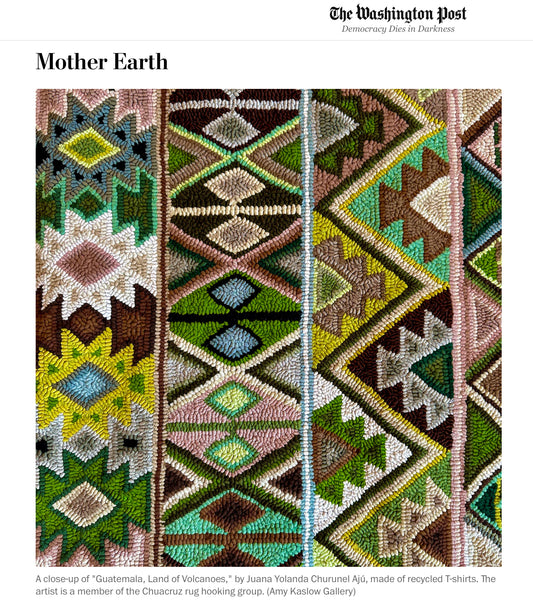April 22 is Earth Day and this week is Fashion Revolution Week, a time to reflect on the human and environmental costs of the textile industry and commemorate the Rana Plaza garment factory collapse that killed 1,132 garment workers in 2011. So it’s a good time to talk about paca!
What is paca?

Paca is the term for imported secondhand clothing. Paca shops are found in most Guatemalan towns. Here in Panajachel, there are dozens of pacas lining the streets. Paca means “bale” in Spanish, and the clothing is named for the way it is shipped from overseas— in bales.
Paca is a complicated issue in Guatemala— on one hand, it’s an affordable source of clothing for many people. On the other hand, the proliferation of Western clothing spilling out of pacas competes with Guatemalan made clothing and handwoven indumentaria maya.
And for Multicolores, paca is the raw material used to create our bold, colorful hand-hooked rugs.
Why use paca?

It wasn’t always this way! During the first rug-hooking workshops in 2009, we tried a mix of materiales: imported wool strips, yarn, and paca. We landed on paca. Why? It’s affordable and it’s everywhere!
This decision—made for practical reasons— also shaped Multicolores’ identity and values as an organization. Environmentally sustainable decision-making became part of our DNA.
“I am happy that we find new uses for secondhand clothing rather than throwing it away. I enjoy setting this example for my family.” -artist Glendy Muj
How does it work?
Artists purchase paca at their local paca store, selecting each piece carefully to build a palette of colors and textures. Artists pay 1 quetzal per garment, about US$0.15– sometimes more if they need a very specific color.
T-shirts work well, but they’re not the only garments that can be used. “I can tell from across the room whether a garment is good for hooking!” said artist Glendy Muj with a laugh. Leggings, light sweatshirts, and almost any jersey material can be used in rugs. The finished rugs are majority cotton, but also include polyester, rayon, or spandex blends.
After washing the garments, artists cut them into strips for hooking. The width of each strip depends on the weight and stretch of the fabric. Some artists love using patterned fabric— look carefully and you will find stripes, camouflage, tie-dye, or printed fabric in their designs. The garments are not overdyed or colored; the colors you see in each rug represent the colors of the original garments.
The result? A large rug (24 x 48 in) typically contains fabric strips cut from 40 to 50 different garments.
A wasteful industry
“We throw away at least half of the clothing. Some garments are stained, torn, full of holes, out of style, or the sizes are too big for our customer,” a local paca owner told me.
With bales arriving weekly to entice clients with new offerings, pacas throw away a lot of clothing. But the waste starts long before the paca shop.
With the rise of fast fashion, the world now consumes 80 billion (!!!) new clothing items each year— a 400% increase in the last 20 years. Over this same 20 year period, the U.S. doubled its creation of textile waste, from 9 million tons in 2000 to 17 million tons in 2018(in 1960, it was 2 million tons).
Overconsumption in the U.S. and Europe spills over borders and becomes the problem of countries like Guatemala, where unsold donated clothing arrives in bales of paca. The clothing that pacas can’t sell gets burned or sent to the landfill.
A small part of the solution
6,626!
That’s how many garments Multicolores’ rug hooking artists recycled in 2020. We tracked this data for the first time last year and we’re proud to celebrate this small positive impact, diverting material from the textile waste flood to create new works of art.
Can I donate my clothing to Multicolores?
We get this question often, and it’s very generous! It would be too costly for us to ship and import your clothing from the U.S., especially when there is already a glut of secondhand clothing in Guatemalan pacas (and landfills).
Instead, we encourage you to take a moment and consider the life cycle of your clothing. Can you repair that torn blouse, patch your jeans, or have your shoes re-soled? Wash your clothes only when needed so that they last longer? Purchase fewer clothing items each year? Together we can all do our part to care for our clothing and the earth.
Learn more:
- Watch the documentary The True Cost
- Writer Aja Barber is one of my favorite voices in the world of sustainability
- Learn about Fashion Revolution week & how to take action to support garment workers’ rights
– Madeline Kreider Carlson
Photo credits: Barbara Lukas, Joe Coca, & Shelly Stokes.




